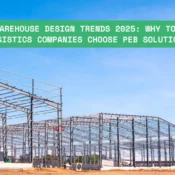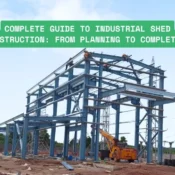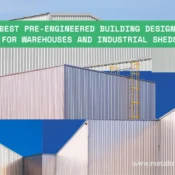
Top Benefits of Pre-Engineered Buildings for Modern Construction
In today’s rapidly evolving construction landscape, efficiency, sustainability, and cost-effectiveness are essential pillars for any successful project. This is where Pre-Engineered Buildings (PEBs) come into play, providing a comprehensive solution that addresses these critical needs. From warehouses and factories to commercial buildings and even residential spaces, pre-engineered buildings have found a place in almost every sector. But what makes them so popular? Let’s dive into the top benefits of pre-engineered buildings and understand why they are the smart choice for modern construction.
In today’s rapidly evolving landscape of modern construction, businesses are grappling with unprecedented challenges. Costs are skyrocketing, skilled labor shortages continue to plague projects, and the increasing demand for environmentally sustainable solutions has companies rethinking their approach. Amidst this chaos, decision-makers in construction and real estate are often faced with the same question:
How do we deliver quality, speed, and sustainability without burning through budgets?
Introducing pre-engineered buildings (PEBs), a game-changing solution that’s quickly gaining popularity in today’s construction world.
The Reality Behind the Rise
We have seen countless businesses in every industry facing a common challenge. As these companies expand their operations to keep up with increasing demand, traditional construction methods often fall short. Delays become routine, costs spiral out of control, and the ability to scale operations becomes a constant hurdle. These businesses need new facilities that can be built quickly and efficiently, with the flexibility to adapt to evolving needs. Sticking to conventional building methods simply isn’t sustainable in such a fast-paced industry.
In response to these growing pains, every industry is turning to pre-engineered buildings (PEBs). They’re finding more than just a quicker way to build—PEBs offer flexibility, streamlined timelines, and cost-effective solutions that traditional construction struggles to provide. This shift isn’t just solving immediate challenges; it’s creating a pathway for long-term growth and operational efficiency.
So, what exactly makes PEBs such a powerful solution in today’s construction landscape?
Let’s dive into how this approach is revolutionizing modern building practices across industries.
What Are Pre-Engineered Buildings?
Pre-engineered buildings (PEBs) are structures that are pre-designed and fabricated at a manufacturing facility. Each component is engineered to fit perfectly with others, reducing the need for extensive on-site modifications. Essentially, it's a system where every element is purposefully created to form a seamless whole.
But what does that mean in practice? Think of it as building with LEGO blocks versus carving each piece of wood to build a house from scratch. This approach provides numerous advantages, allowing for fast construction times, cost savings, and design flexibility. Let’s explore these benefits in more detail.
Faster Construction Times: Speed Up Your Project
One of the most significant advantages of PEBs is the speed at which they can be constructed. When time is of the essence, opting for pre-engineered buildings can reduce project timelines by up to 50%. For businesses, this translates to quicker occupancy, sooner revenue generation, and a competitive edge in their industry.
Unlike traditional construction methods that are at the mercy of weather conditions and labor availability, PEB components are fabricated off-site. This minimizes delays and ensures that installation is streamlined and efficient. When your business relies on infrastructure readiness, every day saved is money earned.
Cost-Effectiveness: A Smarter Way to Build
With rising construction costs being a major concern, pre-engineered buildings offer a financially sound solution. The pre-fabrication process reduces waste, minimizes material costs, and cuts down on labor requirements. All these factors result in substantial savings.
For those companies that needed to expand quickly without breaking the bank, the cost-efficiency of PEBs was a crucial selling point. The savings made in material and labor were redirected towards enhancing the company's core services, allowing them to focus on growth instead of worrying about ballooning construction expenses.
Sustainability: A Greener Approach
In today's environmentally conscious market, businesses are increasingly focused on sustainability. Pre-engineered buildings provide an eco-friendly option by reducing waste during construction and using recyclable materials. Additionally, the improved insulation capabilities of PEBs contribute to energy savings in the long run.
For example, choosing energy-efficient roofing panels and wall cladding can significantly lower heating and cooling costs. As a result, companies not only reduce their carbon footprint but also benefit from lower operational expenses—a win-win for businesses and the planet.
Flexibility in Design: Tailored to Your Needs
One common misconception about pre-engineered buildings is that they are rigid or “one-size-fits-all.” In reality, PEBs offer remarkable flexibility in design. From multi-story office buildings to sprawling warehouses, these structures can be customized to fit a variety of architectural requirements.
Businesses were initially skeptical about whether PEBs could meet their specific needs. However, once they saw the design possibilities, they were convinced. Whether it’s integrating large spans for warehouse spaces or customizing mezzanines for office areas, PEBs cater to diverse requirements without compromising on quality or aesthetics.
Durability and Low Maintenance: Built to Last
Pre-engineered buildings are constructed using high-quality steel and corrosion-resistant materials, ensuring their longevity and durability. This makes them an ideal choice for businesses looking for long-term solutions with minimal upkeep.
For Businesses, this meant that their warehouses and offices didn’t require constant maintenance, allowing them to focus their resources where it mattered most. Unlike traditional buildings that may need regular structural inspections or repairs, PEBs are designed to withstand harsh conditions with minimal wear and tear.
Enhanced Safety and Compliance
When it comes to construction, safety is a non-negotiable priority. PEBs are engineered with stringent safety standards in mind, ensuring that they comply with local building codes and withstand natural disasters like earthquakes or hurricanes.
Businesses can feel confident knowing that their investments are safeguarded against unforeseen events. This peace of mind is priceless, particularly for companies operating in areas prone to severe weather conditions.
Versatility in Application: Serving Diverse Industries
Pre-engineered buildings are versatile, making them suitable for various applications across multiple industries. From manufacturing units to sports complexes, retail stores to schools, PEBs offer tailored solutions to cater to different business needs.
Companies in the agricultural, healthcare, and educational sectors are also turning to PEBs to meet their infrastructure demands. The ability to adapt PEBs for different uses and industries underlines their growing relevance in today’s market.
"Pre-engineered buildings aren’t just revolutionizing construction; they’re empowering businesses to build smarter, adapt faster, and grow sustainably in a world where efficiency and flexibility are the keys to staying ahead of the curve."
Conclusion: The Future of Modern Construction
In an era where efficiency, cost management, and sustainability are more crucial than ever, pre-engineered buildings are becoming the go-to solution for businesses of all sizes. They embody the future of construction—a future where quality isn’t compromised, and speed doesn’t come at an unreasonable cost.
As companies navigate the complexities of modern infrastructure needs, adopting PEBs can be a transformative move. Not only do they promise faster construction, lower costs, and design flexibility, but they also align with the growing emphasis on sustainability and safety.
If your business is facing similar challenges, consider exploring pre-engineered buildings as a viable solution. After all, in the rapidly changing world of construction, the smartest choices aren’t always the most conventional ones.
One thought on “Top Benefits of Pre-Engineered Buildings for Modern Construction”
Add a Comment Cancel reply
All Categories
Recent Posts
Best Pre-Engineered Building Designs for Warehouses and Industrial Sheds
Tags
Call Us at
+91 9311624628





[…] addition, PEBs usually require fewer workers to be present on-site, further enhancing savings. The benefits to the steel building’s construction economics are apparent: decreasing capital expenditures, lesser operational setbacks, and perpetual […]